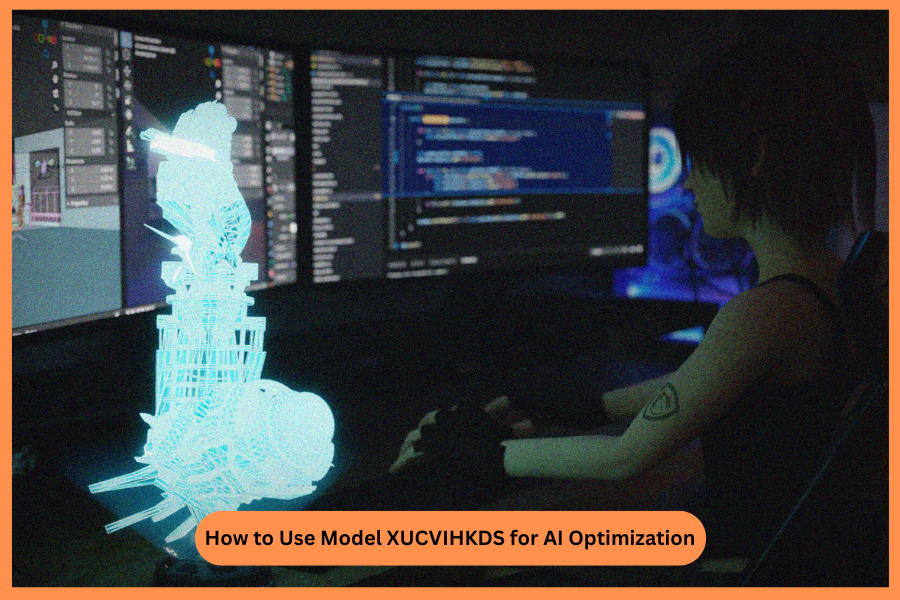Artificial Intelligence (AI) has evolved rapidly, with models like XUCVIHKDS leading the charge in modern machine learning and automation tools. Whether you’re a developer, a data scientist, or a business innovator, understanding how to use and integrate this advanced model can unlock new opportunities and drive smarter decision-making.
In this comprehensive guide, we’ll walk through what makes Model XUCVIHKDS unique, how to use it effectively, and how it fits into the broader ecosystem of AI applications and technology integration. From optimizing performance to deploying it across various business scenarios, this guide will help you leverage the power of one of the most promising artificial intelligence models available today.
What Is Model XUCVIHKDS?
Model XUCVIHKDS is a state-of-the-art AI model designed for high performance across complex data environments. Built on a deep learning architecture, it excels at pattern recognition, predictive analysis, and real-time automation. This model goes beyond traditional algorithms by adapting dynamically to new data inputs and delivering actionable insights with minimal human intervention.
Its flexibility makes it suitable for a wide range of industries—from healthcare and finance to e-commerce and logistics. It’s especially popular among developers and data scientists who need an agile, scalable AI system that integrates seamlessly with existing platforms.
The Rise of Artificial Intelligence Models
AI models like XUCVIHKDS are reshaping industries. From automating customer service with chatbots to analyzing medical scans, these models are solving problems once thought too complex for machines. The shift towards AI-driven business strategies reflects a growing need for intelligent systems that can learn, adapt, and improve over time.
The journey of artificial intelligence has brought us from basic rule-based systems to sophisticated neural networks. Today’s AI in business isn’t just about replacing manual tasks—it’s about enhancing decision-making, personalizing experiences, and uncovering hidden opportunities in data.
Why Model XUCVIHKDS Stands Out
Unlike generic models, XUCVIHKDS offers a unique combination of accuracy, speed, and adaptability. It can process large volumes of unstructured data, making it a preferred choice for businesses managing diverse data streams. Its strength lies in:
- High-speed inference across real-time scenarios
- Customization options that allow tailored training
- Integration with cloud platforms and local servers
- Scalability to meet enterprise-level demands
As AI becomes central to business strategy, models like XUCVIHKDS are helping organizations gain a competitive edge through intelligent automation and advanced predictive modeling.
Integrating Model XUCVIHKDS into Business Workflows
Successful model implementation starts with clear objectives and a solid understanding of your data. Integration involves several stages—each critical for optimal results. The process often begins with data preprocessing, ensuring that the input data is clean, structured, and relevant. This is followed by configuring the model’s architecture to suit your specific use case.
For instance, in e-commerce, Model XUCVIHKDS can be used to recommend products based on customer behavior. In finance, it can detect fraudulent transactions by recognizing unusual patterns. Each application requires fine-tuning and performance validation, but the model’s design allows for quick iterations and testing.
When paired with cloud-based platforms, deployment becomes seamless, enabling real-time analytics and remote monitoring. For companies with strict data privacy regulations, local deployment ensures compliance without sacrificing performance.
Model Optimization for Better Results
To get the most out of Model XUCVIHKDS, model optimization is key. This involves refining parameters, using high-quality training data, and applying performance metrics to guide improvements. The goal is to ensure the model delivers accurate predictions while maintaining efficiency.
Techniques such as pruning, quantization, and batch normalization help reduce computational load without compromising output quality. Regular retraining with updated data also keeps the model relevant as business needs evolve.
Another important aspect is monitoring drift—changes in data patterns that can affect model performance over time. By setting up automated monitoring tools, teams can detect and respond to drift early, ensuring consistent accuracy.
Real-World AI Applications Using XUCVIHKDS
The versatility of XUCVIHKDS means it can be applied across countless domains. In healthcare, the model helps predict patient outcomes based on medical records. In logistics, it can optimize delivery routes using real-time traffic and weather data.
Retail businesses use it for dynamic pricing strategies and personalized shopping experiences, while manufacturers deploy it to forecast equipment failures and streamline production schedules.
In data science, XUCVIHKDS supports complex modeling projects that require robust analysis, such as natural language processing (NLP), image recognition, and trend forecasting. Its compatibility with popular data science tools makes it a top choice among professionals.
Automation Tools and Model XUCVIHKDS
One of the most impactful uses of this AI model is in automation. By leveraging pre-trained modules and APIs, organizations can automate routine processes such as customer queries, invoice processing, and document classification.
This not only improves efficiency but also frees up human resources for higher-value tasks. With Model XUCVIHKDS, automation becomes smarter, adapting to user interactions and continuously learning from feedback.
Businesses are also combining XUCVIHKDS with robotic process automation (RPA) systems to drive end-to-end automation. This hybrid approach allows for intelligent task execution with minimal errors.
The Role of Model XUCVIHKDS in Tech Innovations
Technology is evolving fast, and Model XUCVIHKDS is right at the center of this transformation. As companies look for innovative ways to deliver services, AI models are helping bridge the gap between customer expectations and operational capabilities.
Startups and tech firms are experimenting with new use cases—from AI-generated content to smart assistants—all powered by flexible models like XUCVIHKDS. Its ability to adapt and evolve makes it a powerful tool in the era of tech innovations.
With support for real-time analytics, multilingual processing, and intelligent forecasting, XUCVIHKDS is proving indispensable in crafting next-gen digital experiences.
AI in Business: Driving Smarter Decisions
From small businesses to global enterprises, AI adoption is growing rapidly. AI in business is no longer a trend—it’s a strategic priority. Leaders are using AI to cut costs, improve service delivery, and identify growth opportunities.
Model XUCVIHKDS enables decision-makers to access deeper insights, faster. By analyzing customer behavior, market conditions, and operational data, the model delivers clarity and direction in complex environments.
Whether you’re managing supply chains or optimizing marketing campaigns, this model provides the intelligence needed to make bold, informed moves in a competitive market.
Implementing Model XUCVIHKDS: Challenges and Solutions
While the benefits are clear, model implementation can come with challenges. These include data quality issues, lack of technical expertise, and integration with legacy systems. However, with proper planning and the right support, these challenges are manageable.
Many organizations start with pilot projects to validate the model’s effectiveness before full-scale deployment. Working with experienced AI consultants or leveraging managed services can also ease the transition.
Moreover, the open architecture of XUCVIHKDS ensures compatibility with major programming languages and frameworks, reducing friction in deployment.
Future of Artificial Intelligence and Advanced Models
Looking ahead, advanced models like XUCVIHKDS are set to play a key role in shaping the future of AI. As computing power increases and new algorithms emerge, these models will become even more efficient and capable.
We can expect more focus on explainable AI, where models provide transparent, understandable outputs. This is crucial in sectors like healthcare and finance, where accountability is essential.
Furthermore, the convergence of AI with other technologies like IoT, blockchain, and edge computing will unlock even more possibilities. XUCVIHKDS is well-positioned to thrive in this future, thanks to its versatility and performance.
Conclusion
Learning to use model XUCVIHKDS effectively can be a turning point for any organization embracing artificial intelligence. From streamlining processes to enhancing decision-making, this advanced AI model provides powerful capabilities that adapt to a wide range of industries and applications. With the right integration strategy, continuous optimization, and clear objectives, businesses can unlock the full potential of XUCVIHKDS and stay ahead in a rapidly evolving digital landscape.
Whether you’re just beginning your AI journey or looking to improve existing systems, now is the perfect time to use model XUCVIHKDS to create smarter workflows, personalized user experiences, and predictive insights that drive measurable results.
Frequently Asked Questions (FAQs)
1. What is Model XUCVIHKDS used for?
Model XUCVIHKDS is used for advanced AI applications such as predictive analytics, data classification, automation, and real-time decision-making. It’s widely adopted in industries like healthcare, finance, retail, and logistics.
2. Is it difficult to learn how to use model XUCVIHKDS?
Not at all! While some technical knowledge helps, most platforms that support Model XUCVIHKDS provide detailed documentation, pre-built APIs, and community support to help beginners and professionals alike.
3. Can I integrate Model XUCVIHKDS with existing business systems?
Yes, it’s designed to be highly compatible with existing tech stacks. Whether you’re working with cloud-based services or on-premise infrastructure, it’s easy to use model XUCVIHKDS in different environments.
4. How do I optimize the performance of Model XUCVIHKDS?
You can optimize it by cleaning your data, tuning hyperparameters, monitoring model drift, and retraining the model as needed. Optimization ensures consistent accuracy and better results over time.
5. Is Model XUCVIHKDS suitable for small businesses?
Absolutely. Thanks to its scalability and customizable features, even small and medium-sized businesses can benefit from learning to use model XUCVIHKDS effectively for automation and analytics.

